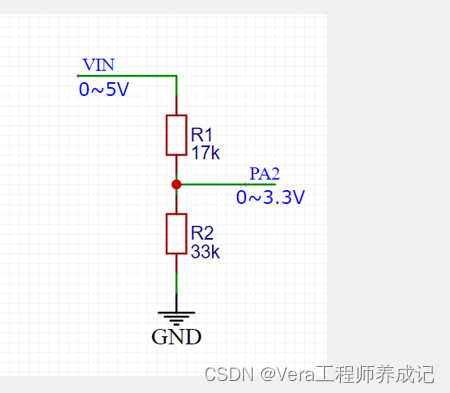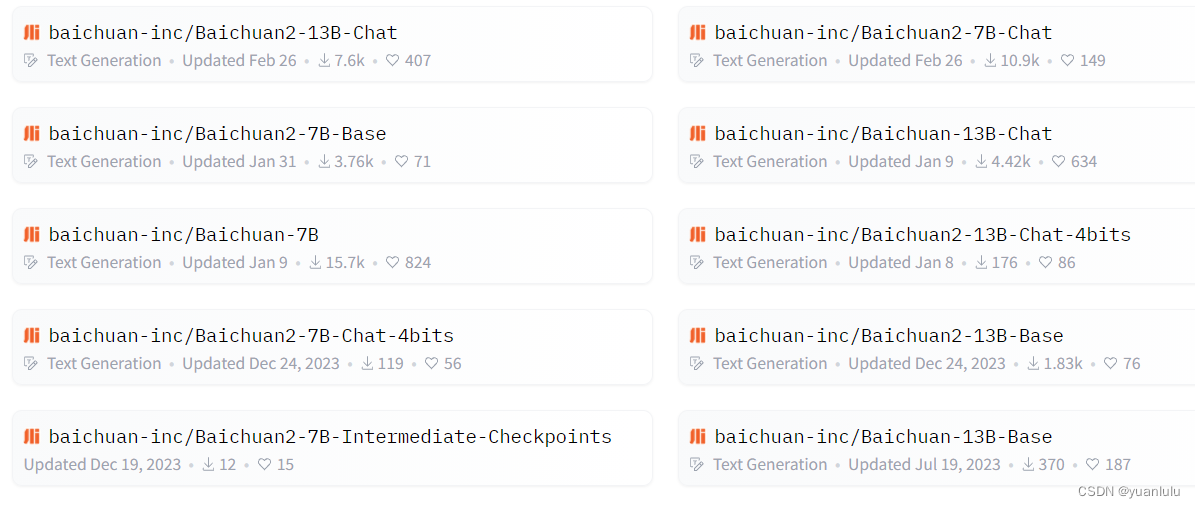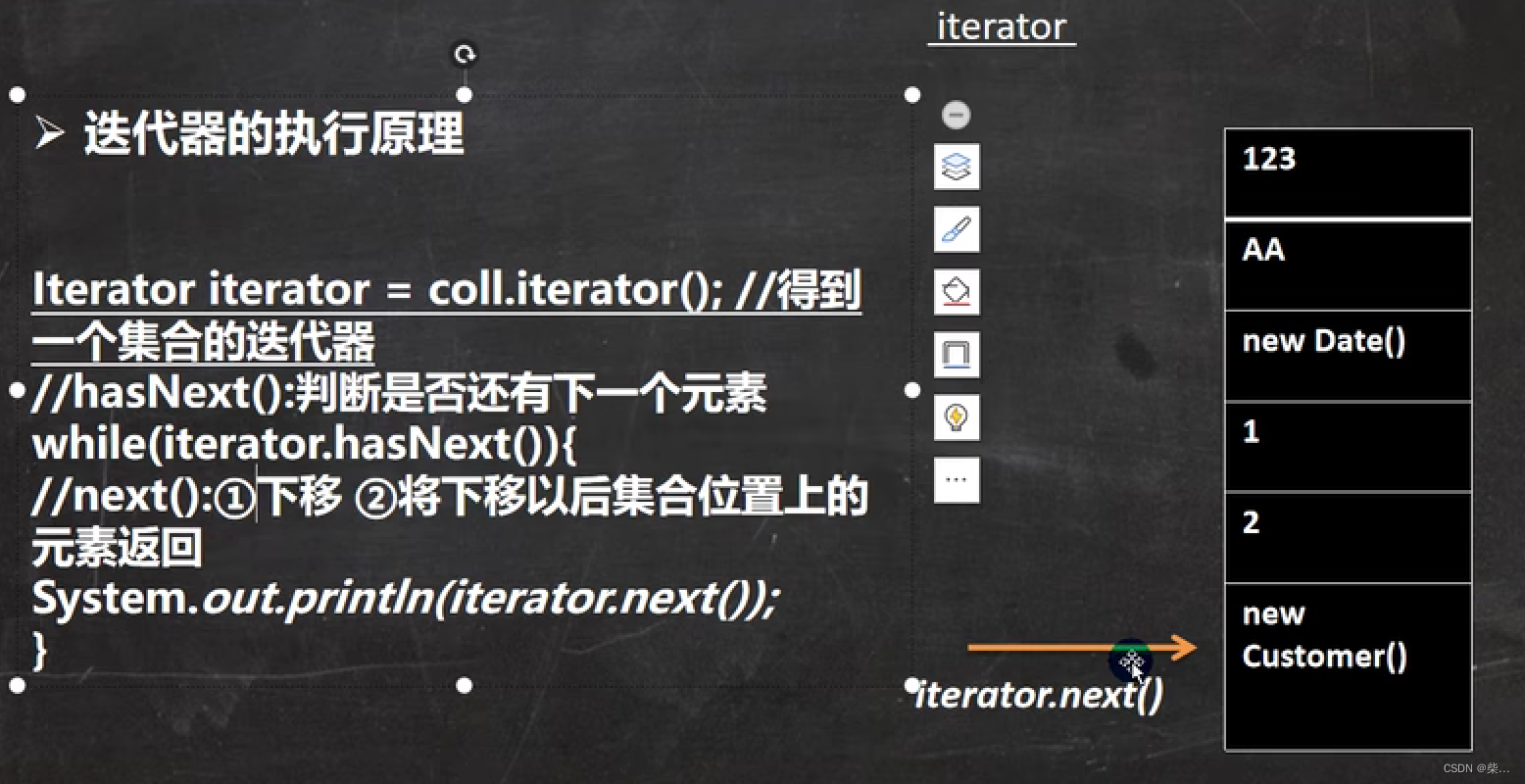什么是FrameBuffer?
Frame 是帧的意思, buffer 是缓冲的意思,所以 Framebuffer 就是帧缓冲, 这意味着 Framebuffer 就是一块内存,里面保存着一帧图像。帧缓冲(framebuffer)是 Linux 系统中的一种显示驱动接口,它将显示设备(譬如 LCD) 进行抽象、 屏蔽了不同显示设备硬件的实现,对应用层抽象为一块显示内存(显存),它允许上层应用程序直接对显示缓冲区进行读写操作,而用户不必关心物理显存的位置等具体细节,这些都由Framebuffer 设备驱动来完成
在 Linux 系统中,显示设备被称为 FrameBuffer 设备(帧缓冲设备),所以 LCD 显示屏自然而言就是 FrameBuffer 设备。 FrameBuffer 设备对应的设备文件为/dev/fbX(X 为数字, 0、 1、 2、 3 等) , Linux下可支持多个 FrameBuffer 设备,最多可达 32 个,分别为/dev/fb0 到/dev/fb31, 开发板出厂系统中, /dev/fb0设备节点便是 LCD 屏。
应用程序读写/dev/fbX 就相当于读写显示设备的显示缓冲区(显存),譬如 LCD 的分辨率是 800*480,每一个像素点的颜色用 24 位(譬如 RGB888)来表示,那么这个显示缓冲区的大小就是 800 x 480 x 24 / 8 = 1152000 个字节。 譬如执行下面这条命令将 LCD 清屏,也就是将其填充为黑色(假设 LCD 对应的设备节点是/dev/fb0,分辨率为 800*480, RGB888 格式):
dd if=/dev/zero of=/dev/fb0 bs=1024 count=1125这条命令的作用就是将 1125x1024 个字节数据全部写入到 LCD 显存中,并且这些数据都是 0x0。
步骤:
在应用程序中,操作/dev/fbX 的一般步骤如下:
①、首先打开/dev/fbX 设备文件。
②、 使用 ioctl()函数获取到当前显示设备的参数信息,譬如屏幕的分辨率大小、像素格式,根据屏幕参数计算显示缓冲区的大小。
③、通过存储映射 I/O 方式将屏幕的显示缓冲区映射到用户空间(mmap)。
④、映射成功后就可以直接读写屏幕的显示缓冲区,进行绘图或图片显示等操作了。
⑤、完成显示后, 调用 munmap()取消映射、并调用 close()关闭设备文件。
使用 ioctl()获取屏幕参数信息:
通 过 ioctl() 函 数 来 获 取 屏 幕 参 数 信 息 , 对 于 Framebuffer 设 备 来 说 , 常 用 的 request 包 括:
1.FBIOGET_VSCREENINFO: 表示获取 FrameBuffer 设备的可变参数信息,可变参数信息使用 struct fb_var_screeninfo 结 构 体 来 描 述 , 所 以 此 时 ioctl() 需 要 有 第 三 个 参 数 , 它 是 一 个 struct fb_var_screeninfo *指针,指向 struct fb_var_screeninfo 类型对象, 调用 ioctl()会将 LCD 屏的可变参数信息保存在 struct fb_var_screeninfo 类型对象中
struct fb_var_screeninfo fb_var;
ioctl(fd, FBIOGET_VSCREENINFO, &fb_var)2.FBIOPUT_VSCREENINFO: 表示设置 FrameBuffer 设备的可变参数信息,既然是可变参数,那说明应用层可对其进行修改、重新配置,当然前提条件是底层驱动支持这些参数的动态调整,譬如在我们的 Windows 系统中,用户可以修改屏幕的显示分辨率,这就是一种动态调整。同样此时 ioctl()需要有第三个参数, 也是一个 struct fb_var_screeninfo *指针,指向 struct fb_var_screeninfo 类型对象, 表示用 struct fb_var_screeninfo 对象中填充的数据设置 LCD, 如下所示:
struct fb_var_screeninfo fb_var = {0};
/* 对 fb_var 进行数据填充 */
......
......
/* 设置可变参数信息 */
ioctl(fd, FBIOPUT_VSCREENINFO, &fb_var)3.FBIOGET_FSCREENINFO: 表示获取 FrameBuffer 设备的固定参数信息,既然是固定参数,那就意味着应用程序不可修改。固定参数信息使用struct fb_fix_screeninfo结构体来描述,所以此时ioctl()需要有第三个参数,它是一个 struct fb_fix_screeninfo *指针,指向 struct fb_fix_screeninfo 类型对象,调用 ioctl()会将 LCD 的固定参数信息保存在 struct fb_fix_screeninfo 对象中,如下所示:
struct fb_fix_screeninfo fb_fix;
ioctl(fd, FBIOGET_FSCREENINFO, &fb_fix);struct fb_var_screeninfo 结构体:
struct fb_var_screeninfo {
__u32 xres; /* 可视区域,一行有多少个像素点, X 分辨率 */
__u32 yres; /* 可视区域,一列有多少个像素点, Y 分辨率 */
__u32 xres_virtual; /* 虚拟区域,一行有多少个像素点 */
__u32 yres_virtual; /* 虚拟区域,一列有多少个像素点 */
__u32 xoffset; /* 虚拟到可见屏幕之间的行偏移 */
__u32 yoffset; /* 虚拟到可见屏幕之间的列偏移 */
__u32 bits_per_pixel; /* 每个像素点使用多少个 bit 来描述,也就是像素深度 bpp */
__u32 grayscale; /* =0 表示彩色, =1 表示灰度, >1 表示 FOURCC 颜色 */
/* 用于描述 R、 G、 B 三种颜色分量分别用多少位来表示以及它们各自的偏移量 */
struct fb_bitfield red; /* Red 颜色分量色域偏移 */
struct fb_bitfield green; /* Green 颜色分量色域偏移 */
struct fb_bitfield blue; /* Blue 颜色分量色域偏移 */
struct fb_bitfield transp; /* 透明度分量色域偏移 */
__u32 nonstd; /* nonstd 等于 0,表示标准像素格式;不等于 0 则表示非标准像素格式 */
__u32 activate;
__u32 height; /* 用来描述 LCD 屏显示图像的高度(以毫米为单位) */
__u32 width; /* 用来描述 LCD 屏显示图像的宽度(以毫米为单位) */
__u32 accel_flags;
/* 以下这些变量表示时序参数 */
__u32 pixclock; /* pixel clock in ps (pico seconds) */
__u32 left_margin; /* time from sync to picture */
__u32 right_margin; /* time from picture to sync */
__u32 upper_margin; /* time from sync to picture */
__u32 lower_margin;
__u32 hsync_len; /* length of horizontal sync */
__u32 vsync_len; /* length of vertical sync */
__u32 sync; /* see FB_SYNC_* */
__u32 vmode; /* see FB_VMODE_* */
__u32 rotate; /* angle we rotate counter clockwise */
__u32 colorspace; /* colorspace for FOURCC-based modes */
__u32 reserved[4]; /* Reserved for future compatibility */
};通过 xres、 yres 获取到屏幕的水平分辨率和垂直分辨率, bits_per_pixel 表示像素深度 bpp,即每一个像素点使用多少个 bit 位来描述它的颜色,通过 xres * yres * bits_per_pixel / 8 计算可得到整个显示缓存区的大小。
red、 green、 blue 描述了 RGB 颜色值中 R、 G、 B 三种颜色通道分别使用多少 bit 来表示以及它们各自的偏移量,通过 red、 green、 blue 变量可知道 LCD 的 RGB 像素格式,譬如是 RGB888 还是 RGB565,亦或者是 BGR888、 BGR565 等。 struct fb_bitfield 结构体如下所示:
struct fb_bitfield {
__u32 offset; /* 偏移量 */
__u32 length; /* 长度 */
__u32 msb_right; /* != 0 : Most significant bit is right */
};struct fb_fix_screeninfo 结构体:
struct fb_fix_screeninfo {
char id[16]; /* 字符串形式的标识符 */
unsigned long smem_start; /* 显存的起始地址(物理地址) */
__u32 smem_len; /* 显存的长度 */
__u32 type;
__u32 type_aux;
__u32 visual;
__u16 xpanstep;
__u16 ypanstep;
__u16 ywrapstep;
__u32 line_length; /* 一行的字节数 */
unsigned long mmio_start; /* Start of Memory Mapped I/O(physical address) */
__u32 mmio_len; /* Length of Memory Mapped I/O */
__u32 accel; /* Indicate to driver which specific chip/card we have */
__u16 capabilities;
__u16 reserved[2];
};smem_start 表示显存的起始地址,这是一个物理地址,当然在应用层无法直接使用; smem_len 表示显存的长度,这个长度并一定等于 LCD 实际的显存大小。 line_length 表示屏幕的一行像素点有多少个字节,通常可以使用 line_length * yres 来得到屏幕显示缓冲区的大小。
程序测试1:
实现:获取 LCD 屏幕的参数信息::
加注释源码:
#include <stdio.h>
#include <stdlib.h>
#include <sys/types.h>
#include <sys/stat.h>
#include <fcntl.h>
#include <unistd.h>
#include <sys/ioctl.h>
#include <linux/fb.h>
int main(int argc, char *argv[])
{
struct fb_fix_screeninfo fb_fix; // 存放固定参数的结构体
struct fb_var_screeninfo fb_var; // 存放可变参数的结构体
int fd; // 文件描述符
/* 打开framebuffer设备 */
if (0 > (fd = open("/dev/fb0", O_WRONLY))) { // 打开framebuffer设备
perror("open error"); // 输出错误信息
exit(-1); // 退出程序
}
/* 获取参数信息 */
ioctl(fd, FBIOGET_VSCREENINFO, &fb_var); // 获取可变参数信息
ioctl(fd, FBIOGET_FSCREENINFO, &fb_fix); // 获取固定参数信息
printf("分辨率: %d*%d\n" // 打印分辨率
"像素深度bpp: %d\n" // 打印像素深度
"一行的字节数: %d\n" // 打印一行的字节数
"像素格式: R<%d %d> G<%d %d> B<%d %d>\n", // 打印像素格式
fb_var.xres, fb_var.yres, fb_var.bits_per_pixel,
fb_fix.line_length,
fb_var.red.offset, fb_var.red.length,
fb_var.green.offset, fb_var.green.length,
fb_var.blue.offset, fb_var.blue.length);
/* 关闭设备文件退出程序 */
close(fd); // 关闭设备文件
exit(0); // 退出程序
}
ioctl系统调用,通过文件描述符fd获取framebuffer设备的可变屏幕参数信息,并将这些信息存储在结构体fb_var和fb_fix中。
测试:
编译:
${CC} -o lcd_info lcd_info.c
上传至开发板:
scp -r book@192.168.5.12:/home/book/project/APP/app/19_lcd/lcd_info /home/root/app
scp -r 【用户名】@【ubuntu的ip地址】:【unbuntu上要传入文件的路径】 【开发板要存入的路径】
下载:

(Tips:正点原子的 RGB LCD 屏幕,包括 4.3 寸 800*480、 4.3 寸 480*272、 7 寸 800*480、 7 寸 1024*600 以及 10.1 寸 1280*800 硬件上均支持 RGB888, 但 ALPHA/Mini I.MX6U 开发板出厂系统中, LCD 驱动程序将其实现为一个 RGB565 格式的显示设备, 用户可修改设备树使其支持 RGB888,或者通过 ioctl 修改。)
程序测试2:
任务:在 LCD 上实现画点(俗称打点)、画线、画矩形等基本 LCD 操作
加注释原码:
#include <stdio.h>
#include <stdlib.h>
#include <sys/types.h>
#include <sys/stat.h>
#include <fcntl.h>
#include <unistd.h>
#include <sys/ioctl.h>
#include <sys/mman.h>
#include <linux/fb.h>
#define argb8888_to_rgb565(color) ({ \
unsigned int temp = (color); \
((temp & 0xF80000UL) >> 8) | \
((temp & 0xFC00UL) >> 5) | \
((temp & 0xF8UL) >> 3); \
})
static int width; // LCD X分辨率
static int height; // LCD Y分辨率
static unsigned short *screen_base = NULL; // 映射后的显存基地址
/********************************************************************
* 函数名称: lcd_draw_point
* 功能描述: 打点
* 输入参数: x, y, color
* 返 回 值: 无
********************************************************************/
static void lcd_draw_point(unsigned int x, unsigned int y, unsigned int color)
{
unsigned short rgb565_color = argb8888_to_rgb565(color); // 得到RGB565颜色值
/* 对传入参数的校验 */
if (x >= width)
x = width - 1;
if (y >= height)
y = height - 1;
/* 填充颜色 */
screen_base[y * width + x] = rgb565_color;
}
/********************************************************************
* 函数名称: lcd_draw_line
* 功能描述: 画线(水平或垂直线)
* 输入参数: x, y, dir, length, color
* 返 回 值: 无
********************************************************************/
static void lcd_draw_line(unsigned int x, unsigned int y, int dir,
unsigned int length, unsigned int color)
{
unsigned short rgb565_color = argb8888_to_rgb565(color); // 得到RGB565颜色值
unsigned int end;
unsigned long temp;
/* 对传入参数的校验 */
if (x >= width)
x = width - 1;
if (y >= height)
y = height - 1;
/* 填充颜色 */
temp = y * width + x; // 定位到起点
if (dir) { // 水平线
end = x + length - 1;
if (end >= width)
end = width - 1;
for (; x <= end; x++, temp++)
screen_base[temp] = rgb565_color;
} else { // 垂直线
end = y + length - 1;
if (end >= height)
end = height - 1;
for (; y <= end; y++, temp += width)
screen_base[temp] = rgb565_color;
}
}
/********************************************************************
* 函数名称: lcd_draw_rectangle
* 功能描述: 画矩形
* 输入参数: start_x, end_x, start_y, end_y, color
* 返 回 值: 无
********************************************************************/
static void lcd_draw_rectangle(unsigned int start_x, unsigned int end_x,
unsigned int start_y, unsigned int end_y,
unsigned int color)
{
int x_len = end_x - start_x + 1;
int y_len = end_y - start_y - 1;
lcd_draw_line(start_x, start_y, 1, x_len, color); // 上边
lcd_draw_line(start_x, end_y, 1, x_len, color); // 下边
lcd_draw_line(start_x, start_y + 1, 0, y_len, color); // 左边
lcd_draw_line(end_x, start_y + 1, 0, y_len, color); // 右边
}
/********************************************************************
* 函数名称: lcd_fill
* 功能描述: 将一个矩形区域填充为参数color所指定的颜色
* 输入参数: start_x, end_x, start_y, end_y, color
* 返 回 值: 无
********************************************************************/
static void lcd_fill(unsigned int start_x, unsigned int end_x,
unsigned int start_y, unsigned int end_y,
unsigned int color)
{
unsigned short rgb565_color = argb8888_to_rgb565(color); // 得到RGB565颜色值
unsigned long temp;
unsigned int x;
/* 对传入参数的校验 */
if (end_x >= width)
end_x = width - 1;
if (end_y >= height)
end_y = height - 1;
/* 填充颜色 */
temp = start_y * width; // 定位到起点行首
for (; start_y <= end_y; start_y++, temp += width) {
for (x = start_x; x <= end_x; x++)
screen_base[temp + x] = rgb565_color;
}
}
int main(int argc, char *argv[])
{
struct fb_fix_screeninfo fb_fix;
struct fb_var_screeninfo fb_var;
unsigned int screen_size;
int fd;
/* 打开framebuffer设备 */
if (0 > (fd = open("/dev/fb0", O_RDWR))) {
perror("open error");
exit(EXIT_FAILURE);
}
/* 获取参数信息 */
ioctl(fd, FBIOGET_VSCREENINFO, &fb_var);
ioctl(fd, FBIOGET_FSCREENINFO, &fb_fix);
screen_size = fb_fix.line_length * fb_var.yres;
width = fb_var.xres;
height = fb_var.yres;
/* 将显示缓冲区映射到进程地址空间 */
screen_base = mmap(NULL, screen_size, PROT_WRITE, MAP_SHARED, fd, 0);
if (MAP_FAILED == (void *)screen_base) {
perror("mmap error");
close(fd);
exit(EXIT_FAILURE);
}
/* 画正方形方块 */
int w = height * 0.25; // 方块的宽度为1/4屏幕高度
lcd_fill(0, width - 1, 0, height - 1, 0x0); // 清屏(屏幕显示黑色)
lcd_fill(0, w, 0, w, 0xFF0000); // 红色方块
lcd_fill(width - w, width - 1, 0, w, 0xFF00); // 绿色方块
lcd_fill(0, w, height - w, height - 1, 0xFF); // 蓝色方块
lcd_fill(width - w, width - 1, height - w, height - 1, 0xFFFF00); // 黄色方块
/* 画线: 十字交叉线 */
lcd_draw_line(0, height * 0.5, 1, width, 0xFFFFFF); // 白色线
lcd_draw_line(width * 0.5, 0, 0, height, 0xFFFFFF); // 白色线
/* 画矩形 */
unsigned int s_x, s_y, e_x, e_y;
s_x = 0.25 * width;
s_y = w;
e_x = width - s_x;
e_y = height - s_y;
for (; (s_x <= e_x) && (s_y <= e_y); s_x += 5, s_y += 5, e_x -= 5, e_y -= 5)
lcd_draw_rectangle(s_x, e_x, s_y, e_y, 0xFFFFFF);
/* 退出 */
munmap(screen_base, screen_size); // 取消映射
close(fd); // 关闭文件
exit(EXIT_SUCCESS); // 退出进程
}
部分代码解释:
1.
/* 将显示缓冲区映射到进程地址空间 */
screen_base = mmap(NULL, screen_size, PROT_WRITE, MAP_SHARED, fd, 0);
if (MAP_FAILED == (void *)screen_base) {
perror("mmap error");
close(fd);
exit(EXIT_FAILURE);
}
mmap函数:
mmap(memory map)函数用于将文件或设备的一部分内容映射到进程的地址空间中,从而可以直接通过内存访问的方式来操作这些内容。- 在这里,
mmap的作用是将framebuffer设备的显示缓冲区映射到进程的地址空间中,使得程序可以直接通过操作screen_base指针来修改显示内容,而无需通过读写文件的方式。
参数解释:
NULL:表示让系统自动选择映射的起始地址。screen_size:映射区域的大小,即显示缓冲区的大小,由fb_fix.line_length * fb_var.yres计算得出。PROT_WRITE:映射区域可写,表示允许通过screen_base指针写入数据到映射的内存区域。MAP_SHARED:映射区域被多个进程共享,对映射区域的写入会直接反映到文件或设备中。fd:已经打开的framebuffer设备文件描述符。0:表示映射的起始偏移量,通常为0,即从文件或设备的开头开始映射。
2.
munmap(screen_base, screen_size); // 取消映射munmap 函数:
munmap函数用于取消之前通过mmap建立的内存映射。- 它接受两个参数:
screen_base是之前通过mmap返回的映射到进程地址空间的指针,screen_size是映射区域的大小。 - 调用
munmap函数后,操作系统会解除该内存区域与进程地址空间的映射关系,并释放相关资源。
3.程序中自定义了 4 个函数:
lcd_draw_point: 用于实现画点、打点操作,参数 x 和 y 指定像素点的位置,参数 color 表示颜色。
lcd_draw_line: 用于实现画线操作,参数 x 和 y 指定线的起始位置;参数 dir 表示方向,水平方向(dir!=0)还是垂直方向(dir=0),不支持斜线画法,画斜线需要一些算法去操作,这不是本章内容需要去关注的知识点;参数 length 表示线的长度,以像素为单位;参数 color 表示线条的颜色。
lcd_draw_rectangle: 用于实现画矩形操作,参数 start_x 和 start_y 指定矩形左上角的位置;参数 end_x和 end_y 指定矩形右下角的位置;参数 color 指定矩形 4 个边的线条颜色。
lcd_fill: 将一个指定的矩形区域填充为参数 color 指定的颜色,参数 start_x 和 start_y 指定矩形左上角的位置;参数 end_x 和 end_y 指定矩形右下角的位置;参数 color 指定矩形区域填充的颜色。
4.程序流程:
(1) 首先调用 open()打开 LCD 设备文件得到文件描述符 fd;
(2)接着使用 ioctl 函数获取 LCD 的可变参数信息和固定参数信息,通过得到的信息计算 LCD 显存大小、得到 LCD 屏幕的分辨率,从图 19.3.1 可知, ALPHA/Mini I.MX6U 开发板出厂系统将 LCD 实现为一个 RGB565 显示设备,所以程序中自定义的 4 个函数在操作 LCD 像素点时、都是以 RGB565的格式写入颜色值。
(3)接着使用 mmap 建立映射;映射成功之后就可以在应用层直接操作 LCD 显存了,调用自定义的函数在 LCD 上画线、画矩形、画方块;
(4)操作完成之后,调用 munmap 取消映射,调用 close 关闭 LCD 设备文件,退出程序。
5.颜色判断:
在RGB颜色模型中,颜色是由红色(R)、绿色(G)、蓝色(B)三个通道的组合来表示的。每个通道的取值范围是0到255(或者用十六进制表示就是00到FF)。
-
0xFF 和 0xFF00 的颜色表示:
0xFF表示的是一个八位整数的高位,即11111111,对应于RGB颜色模型中的一个完全饱和的颜色通道。0xFF的十六进制表示为0x0000FF,这表示的是纯蓝色。0xFF00表示的是一个十六位整数的高位,即1111111100000000。0xFF00的十六进制表示为0x00FF00,这表示的是纯绿色。
-
十六进制颜色表示:
- 在RGB颜色模型中,颜色值的表示方式是由红色、绿色和蓝色通道的强度组合而成。例如:
0x0000FF表示纯蓝色(B通道最大,R和G通道为0)。0x00FF00表示纯绿色(G通道最大,R和B通道为0)。0xFF0000表示纯红色(R通道最大,G和B通道为0)。
- 在RGB颜色模型中,颜色值的表示方式是由红色、绿色和蓝色通道的强度组合而成。例如:
测试:
开发板先退出桌面程序:设置->退出桌面应用
编译:
传至开发板,
scp -r book@192.168.5.12:/home/book/project/APP/app/19_lcd/lcd_test /home/root/app
测试成功:

LCD 应用编程练习之显示 BMP 图片:
最常用图片类型的有三种: JPEG(或 JPG)、 PNG、 BMP 和 GIF。其中 JPEG (或 JPG)、 PNG 以及 BMP 都是静态图片,而 GIF 则可以实现动态图片。
BMP(全称 Bitmap)是 Window 操作系统中的标准图像文件格式,文件后缀名为“.bmp”,使用非常广。它采用位映射存储格式,除了图像深度可选以外,图像数据没有进行任何压缩,因此, BMP 图像文件所占用的空间很大,但是没有失真、 并且解析 BMP 图像简单。
BMP 文件的图像深度可选 lbit、 4bit、 8bit、 16bit、 24bit 以及 32bit, 典型的 BMP 图像文件由四部分组成:
①、 BMP 文件头(BMP file header),它包含 BMP 文件的格式、大小、 位图数据的偏移量等信息;
②、位图信息头(bitmap information) ,它包含位图信息头大小、 图像的尺寸、 图像大小、 位平面数、压缩方式以及颜色索引等信息;
③、调色板(color palette),这部分是可选的,如果使用索引来表示图像, 调色板就是索引与其对应颜色的映射表;
④、位图数据(bitmap data),也就是图像数据。

一般常见的图像都是以 16 位(R、 G、 B 三种颜色分别使用 5bit、 6bit、 5bit 来表示)、 24 位(R、 G、B 三种颜色都使用 8bit 来表示) 色图像为主
以一张 BMP 图像为例 ,如下图所示
对图片右键属性,可知其为16位的bmp图片:

可以看到该图片的分辨率为 800*480,位深度为 16bit,每个像素点使用 16 位表示,也就是 RGB565。为了向大家介绍 BMP 文件结构,接下来使用十六进制查看工具将 image.bmp 文件打开,文件头部分的内容如下所示:
1.bmp 文件头
Windows 下为 bmp 文件头定义了如下结构体:
typedef struct tagBITMAPFILEHEADER
{
UINT16 bfType;
DWORD bfSize;
UINT16 bfReserved1;
UINT16 bfReserved2;
DWORD bfOffBits;
} BITMAPFILEHEADER;结构体中每一个成员说明如下;


二、 位图信息头
三、 调色板
四、 位图数据
略,感兴趣的同学可以自己去了解了解这些,网上很多。
程序测试3:
实现:在 LCD 上显示一张指定的 BMP 图像
带注释源码:
#include <stdio.h>
#include <stdlib.h>
#include <sys/types.h>
#include <sys/stat.h>
#include <fcntl.h>
#include <unistd.h>
#include <sys/ioctl.h>
#include <string.h>
#include <linux/fb.h>
#include <sys/mman.h>
/**** BMP文件头数据结构 ****/
typedef struct {
unsigned char type[2]; // 文件类型
unsigned int size; // 文件大小
unsigned short reserved1; // 保留字段1
unsigned short reserved2; // 保留字段2
unsigned int offset; // 到位图数据的偏移量
} __attribute__ ((packed)) bmp_file_header;
/**** 位图信息头数据结构 ****/
typedef struct {
unsigned int size; // 位图信息头大小
int width; // 图像宽度
int height; // 图像高度
unsigned short planes; // 位面数
unsigned short bpp; // 像素深度
unsigned int compression; // 压缩方式
unsigned int image_size; // 图像大小
int x_pels_per_meter; // 像素/米
int y_pels_per_meter; // 像素/米
unsigned int clr_used;
unsigned int clr_important;
} __attribute__ ((packed)) bmp_info_header;
/**** 静态全局变量 ****/
static int width; // LCD X分辨率
static int height; // LCD Y分辨率
static unsigned short *screen_base = NULL; // 映射后的显存基地址
static unsigned long line_length; // LCD一行的长度(字节为单位)
/********************************************************************
* 函数名称: show_bmp_image
* 功能描述: 在LCD上显示指定的BMP图片
* 输入参数: 文件路径
* 返回值: 成功返回0, 失败返回-1
********************************************************************/
static int show_bmp_image(const char *path)
{
bmp_file_header file_h;
bmp_info_header info_h;
unsigned short *line_buf = NULL; // 行缓冲区
unsigned long line_bytes; // BMP图像一行的字节的大小
unsigned int min_h, min_bytes;
int fd = -1;
int j;
/* 打开文件 */
if (0 > (fd = open(path, O_RDONLY))) {
perror("open error");
return -1;
}
/* 读取BMP文件头 */
if (sizeof(bmp_file_header) != read(fd, &file_h, sizeof(bmp_file_header))) {
perror("read error");
close(fd);
return -1;
}
if (0 != memcmp(file_h.type, "BM", 2)) {
fprintf(stderr, "it's not a BMP file\n");
close(fd);
return -1;
}
/* 读取位图信息头 */
if (sizeof(bmp_info_header) != read(fd, &info_h, sizeof(bmp_info_header))) {
perror("read error");
close(fd);
return -1;
}
/* 打印信息 */
printf("文件大小: %d\n"
"位图数据的偏移量: %d\n"
"位图信息头大小: %d\n"
"图像分辨率: %d*%d\n"
"像素深度: %d\n", file_h.size, file_h.offset,
info_h.size, info_h.width, info_h.height,
info_h.bpp);
/* 将文件读写位置移动到图像数据开始处 */
if (-1 == lseek(fd, file_h.offset, SEEK_SET)) {
perror("lseek error");
close(fd);
return -1;
}
/* 申请一个buf、暂存bmp图像的一行数据 */
line_bytes = info_h.width * info_h.bpp / 8;
line_buf = malloc(line_bytes);
if (NULL == line_buf) {
fprintf(stderr, "malloc error\n");
close(fd);
return -1;
}
if (line_length > line_bytes)
min_bytes = line_bytes;
else
min_bytes = line_length;
/**** 读取图像数据显示到LCD ****/
if (0 < info_h.height) { // 倒向位图
if (info_h.height > height) {
min_h = height;
lseek(fd, (info_h.height - height) * line_bytes, SEEK_CUR);
screen_base += width * (height - 1); // 定位到屏幕左下角位置
} else {
min_h = info_h.height;
screen_base += width * (info_h.height - 1); // 定位到屏幕左下角位置
}
for (j = min_h; j > 0; screen_base -= width, j--) {
read(fd, line_buf, line_bytes); // 读取出图像数据
memcpy(screen_base, line_buf, min_bytes); // 刷入LCD显存
}
} else { // 正向位图
int temp = 0 - info_h.height; // 负数转成正数
if (temp > height)
min_h = height;
else
min_h = temp;
for (j = 0; j < min_h; j++, screen_base += width) {
read(fd, line_buf, line_bytes);
memcpy(screen_base, line_buf, min_bytes);
}
}
/* 关闭文件、释放内存、函数返回 */
close(fd);
free(line_buf);
return 0;
}
int main(int argc, char *argv[])
{
struct fb_fix_screeninfo fb_fix;
struct fb_var_screeninfo fb_var;
unsigned int screen_size;
int fd;
/* 参数校验 */
if (2 != argc) {
fprintf(stderr, "usage: %s <bmp_file>\n", argv[0]);
exit(-1);
}
/* 打开framebuffer设备 */
if (0 > (fd = open("/dev/fb0", O_RDWR))) {
perror("open error");
exit(EXIT_FAILURE);
}
/* 获取参数信息 */
ioctl(fd, FBIOGET_VSCREENINFO, &fb_var);
ioctl(fd, FBIOGET_FSCREENINFO, &fb_fix);
screen_size = fb_fix.line_length * fb_var.yres;
line_length = fb_fix.line_length;
width = fb_var.xres;
height = fb_var.yres;
/* 将显示缓冲区映射到进程地址空间 */
screen_base = mmap(NULL, screen_size, PROT_WRITE, MAP_SHARED, fd, 0);
if (MAP_FAILED == (void *)screen_base) {
perror("mmap error");
close(fd);
exit(EXIT_FAILURE);
}
/* 在LCD上显示BMP图片 */
memset(screen_base, 0xFF, screen_size); // 清空屏幕为白色
show_bmp_image(argv[1]); // 显示BMP图片
/* 退出 */
munmap(screen_base, screen_size); // 取消映射
close(fd); // 关闭文件
exit(EXIT_SUCCESS); // 退出进程
}
代码中有两个自定义结构体 bmp_file_header 和 bmp_info_header,描述 bmp 文件头的数据结构bmp_file_header、以及描述位图信息头的数据结构 bmp_info_header。
当执行程序时候,需要传入参数,指定一个 bmp 文件。 main()函数中会调用 show_bmp_image()函数在LCD 上显示 bmp 图像, show_bmp_image()函数的参数为 bmp 文件路径,在 show_bmp_image()函数中首先会打开指定路径的 bmp 文件,得到对应的文件描述符 fd,接着调用 read()函数读取 bmp 文件头和位图信息头。
获取到信息之后使用 printf 将其打印出来,接着使用 lseek()函数将文件的读写位置移动到图像数据起始位置处,也就是 bmp_file_header 结构体中的 offset 变量指定的地址偏移量。
程序流程:
-
包含必要的头文件:包括标准库、系统调用、Linux framebuffer相关的头文件。
-
定义BMP文件头和位图信息头结构体:分别表示BMP文件的文件头和图像信息头,使用
__attribute__ ((packed))确保结构体按照实际字节对齐。 -
声明静态全局变量:包括LCD的分辨率、映射后的显存基地址以及一行的长度。
-
show_bmp_image函数:
- 打开并读取BMP文件:打开指定路径的BMP文件,读取文件头和信息头,验证文件类型和BMP格式。
- 获取和打印图像信息:打印出文件大小、图像数据偏移量、图像分辨率、像素深度等信息。
- 设置读取位置:将文件指针移动到图像数据的起始位置。
- 准备显存和行缓冲区:根据图像宽度和像素深度计算每行数据的大小,申请行缓冲区的内存。
- 读取并显示图像数据到LCD:根据位图是否为倒向或正向,逐行读取图像数据并拷贝到LCD显存中,完成图像显示。
- 关闭文件和释放内存:关闭BMP文件,释放申请的内存空间,函数返回。
-
main函数:
- 参数验证:检查参数个数,确保传入了BMP文件路径。
- 打开并配置framebuffer设备:打开
/dev/fb0设备文件,获取并存储屏幕信息,包括像素分辨率和一行的字节数。 - 映射framebuffer到内存空间:使用
mmap将framebuffer映射到进程的地址空间,以便直接操作显存。 - 清空屏幕并显示BMP图像:将屏幕清空为白色,调用
show_bmp_image函数显示指定的BMP图像。 - 释放映射和关闭文件:取消映射framebuffer,关闭设备文件,正常退出程序。
测试:

scp传至开发板,将程序文件和bmp图片均传过来

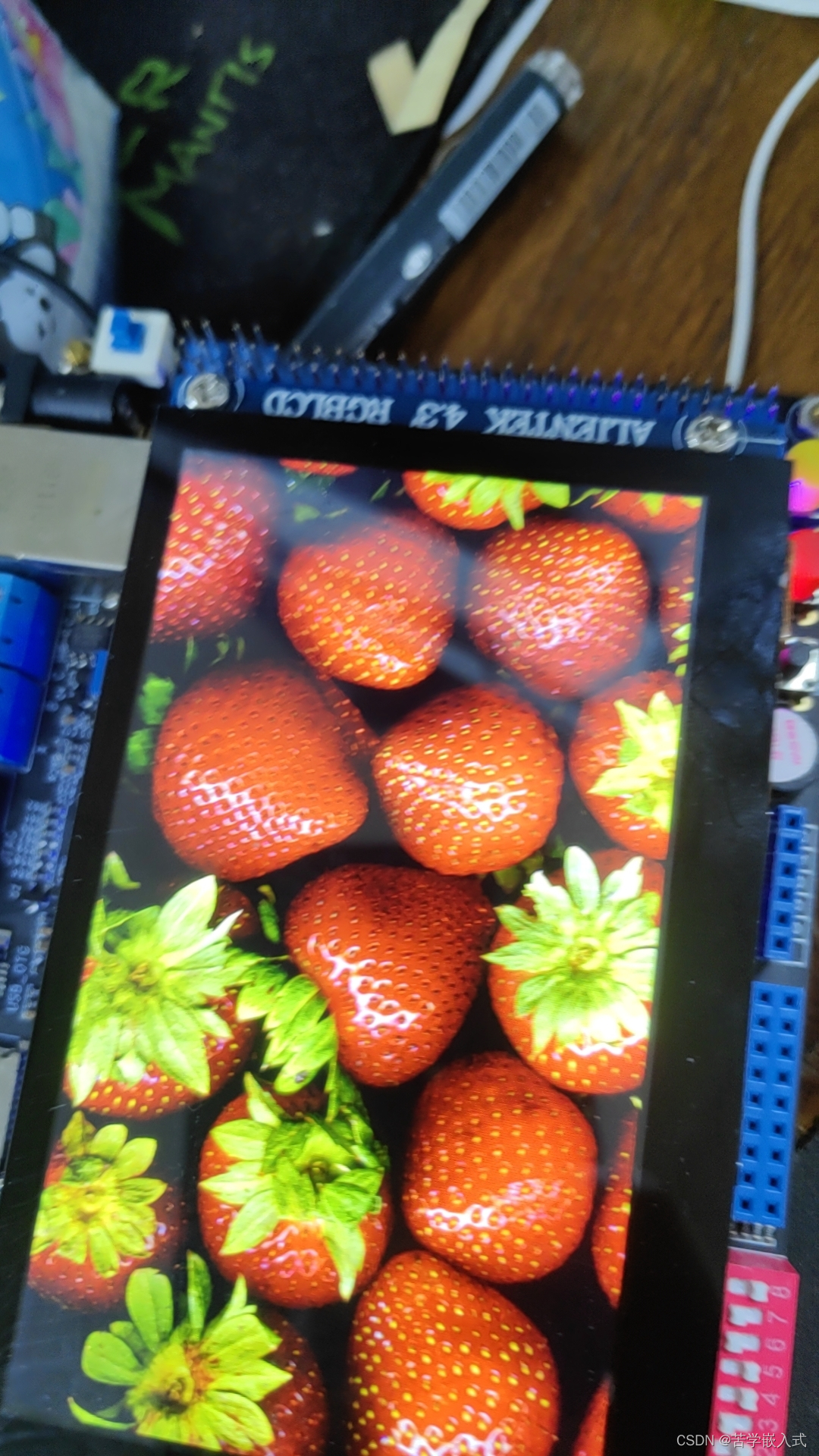
成功!







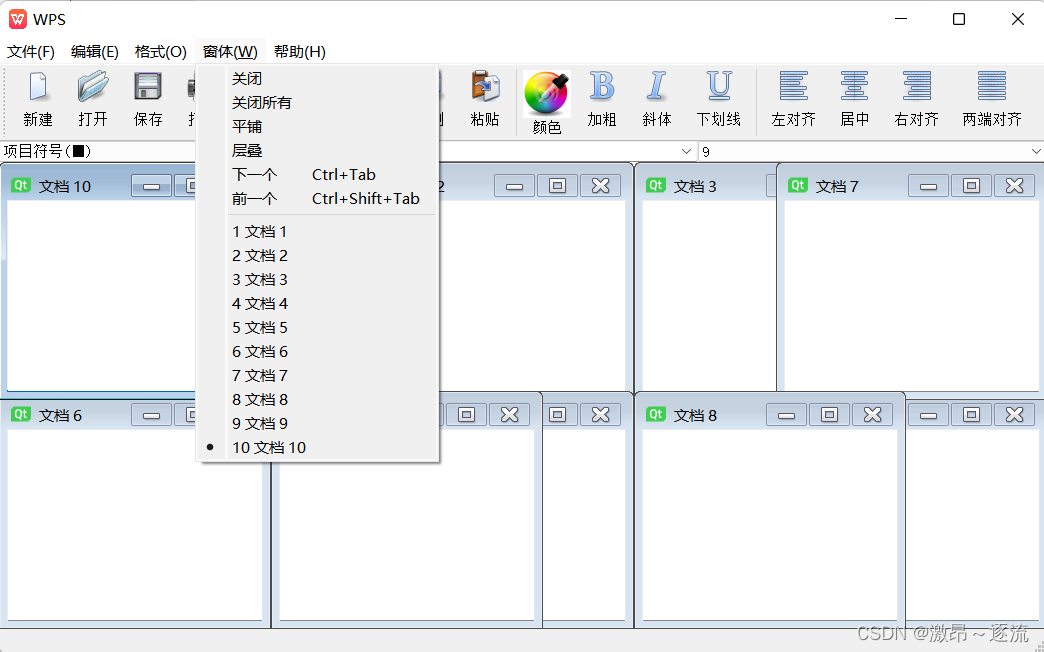


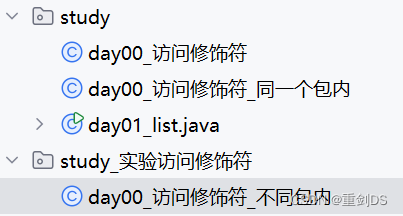
![[Go 微服务] go-micro + consul 的使用](https://img-blog.csdnimg.cn/direct/480ef57be4364cfbabcc63e8979c242b.png)
